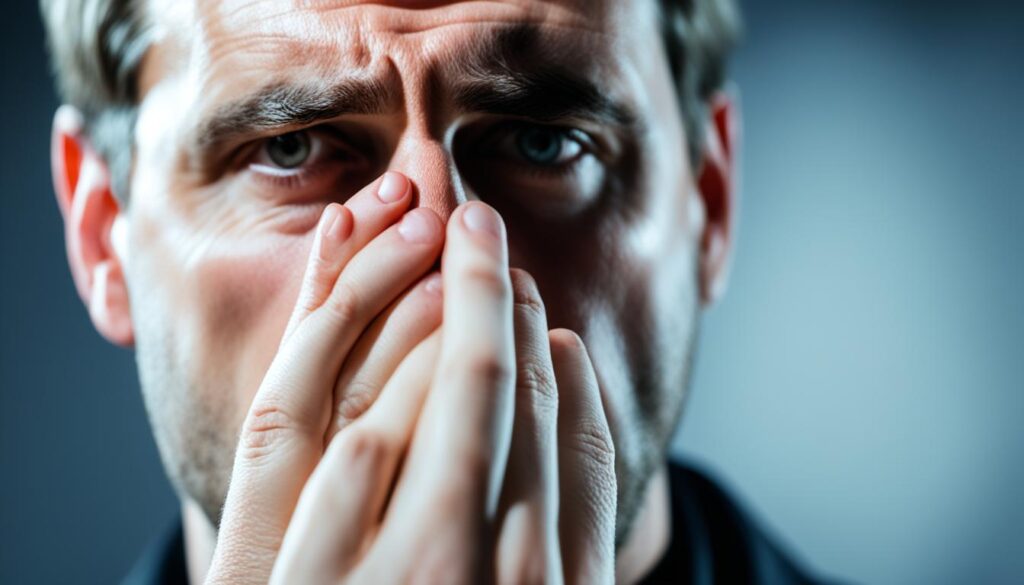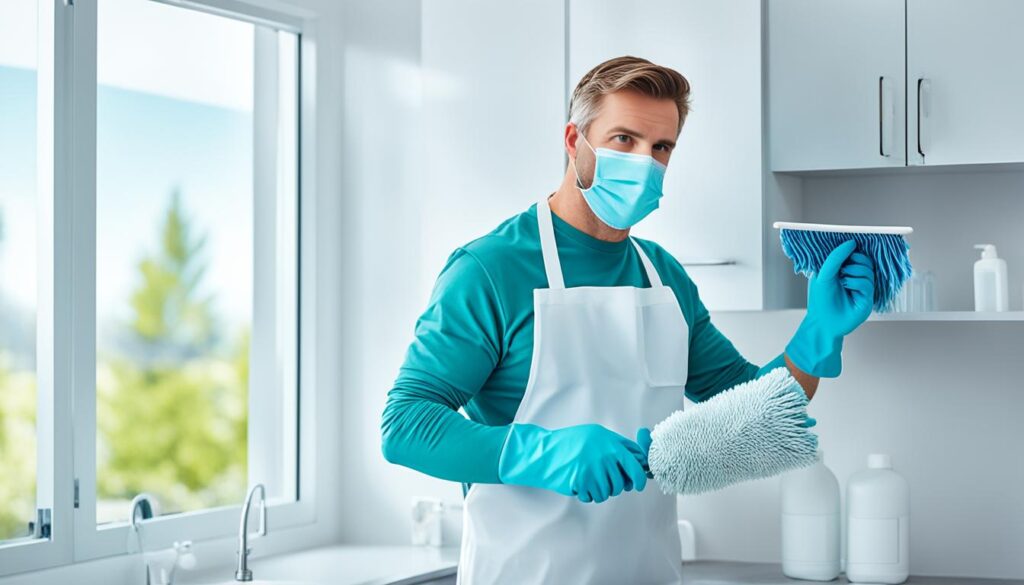
Understanding Mold Symptoms: Health Effects
Mold is a common household issue that can have a significant impact on our health and wellbeing. The presence of mold in indoor environments has been linked to various health effects, making it crucial to recognize mold symptoms and take appropriate action to maintain good indoor air quality.
Prolonged exposure to mold can result in a range of health issues, including respiratory problems, allergic reactions, and even infections. Individuals with respiratory conditions such as asthma or allergies may experience worsening symptoms when exposed to mold spores. Moreover, mold can release harmful mycotoxins that can cause neurological symptoms and affect our overall wellbeing.
Recognizing mold symptoms is essential for identifying potential mold infestations and addressing them promptly. By understanding the signs to look out for, you can take proactive measures to minimize mold exposure in your living and working spaces, ensuring a healthier environment for yourself and your loved ones.
Key Takeaways:
- Mold exposure can lead to various health effects and worsen respiratory conditions.
- Recognizing mold symptoms is crucial for maintaining good indoor air quality.
- Prolonged mold exposure can result in allergic reactions, infections, and neurological symptoms.
- Taking proactive steps to minimize mold exposure can help improve overall wellbeing.
- Professional mold assessment, prevention, and remediation services are available to address mold infestations effectively.
Recognizing Mold Symptoms: Signs to Look Out For
Recognizing the signs and symptoms of mold exposure is essential for maintaining a healthy indoor environment. Mold can frequently go unnoticed, but its impact on air quality and overall well-being should not be underestimated. Here, we will explore the various indicators that may suggest the presence of mold in your living or working space.
Visible Signs of Mold
One of the most apparent signs of mold is visible growth. Mold often appears as discolored patches or spots on walls, ceilings, or other surfaces. These growths may be green, black, brown, or even white in color. If you notice any unusual discoloration, it could potentially be a sign of mold infestation.
Musty Odor
A distinct musty smell is another common indication of mold. If you detect an unpleasant, earthy scent, especially in closed or humid areas, it may be a sign that mold is growing nearby. Persistent odor should not be ignored, as it might be an indication of hidden mold sources.
Allergic Reactions
Mold exposure can trigger allergic reactions in many individuals. These reactions may include sneezing, coughing, wheezing, watery eyes, nasal congestion, or skin irritation. If you experience these symptoms consistently, especially when spending time in specific areas, it may suggest the presence of mold.
Respiratory Issues
Exposure to mold spores can cause respiratory problems, particularly in individuals with pre-existing conditions such as asthma or allergies. If you notice an increase in coughing, wheezing, shortness of breath, or other respiratory issues, it is important to consider the possibility of mold being a contributing factor.
Physical Discomfort
General physical discomfort can also be associated with mold exposure. This may include fatigue, headaches, difficulty concentrating, or feeling unwell without an obvious cause. If you or others in your space experience these symptoms and they appear to be linked to specific areas or environments, mold exposure should be considered.
Testing and Professional Assessment
If you suspect mold but are unsure, professional mold testing and assessment can provide accurate confirmation. Certified professionals can identify the type and extent of mold infestation in your space, helping you take appropriate steps to address the issue.
Recognizing mold symptoms is crucial for maintaining a healthy indoor environment. By being aware of these signs and taking prompt action, you can protect your well-being and ensure the best possible air quality where you live or work.
Next, in Section 3, we will provide practical tips and strategies for preventing mold growth and minimizing mold exposure.

Minimizing Mold Exposure: Prevention and Remediation
Preventing mold growth and minimizing mold exposure is crucial for maintaining a healthy indoor environment. By implementing the following tips and strategies, you can effectively reduce the risk of mold in your surroundings.
1. Control Indoor Moisture Levels
Mold thrives in moist environments, so it’s essential to keep your home or workplace dry. Regularly inspect your property for any leaks, water damage, or plumbing issues that may contribute to excess moisture. Fixing these problems promptly can help prevent mold growth.
2. Proper Ventilation
Improving ventilation is key to minimizing mold exposure. Ensure that bathrooms, kitchens, and other areas prone to moisture have adequate ventilation systems. This helps to reduce humidity levels and prevent condensation that can lead to mold growth.
3. Use Dehumidifiers
If you live in a humid climate or struggle with high indoor humidity, consider using dehumidifiers. These devices remove moisture from the air and help maintain optimal humidity levels, inhibiting mold growth.
4. Regular Cleaning and Maintenance
Regularly clean and inspect areas where mold is commonly found, such as bathrooms, basements, and crawl spaces. Use mold-resistant products and cleaning solutions to prevent mold growth. Pay attention to hidden areas where moisture can accumulate, such as under sinks, behind appliances, and in air conditioning units.
5. Promptly Address Water Intrusions
If you experience any water intrusions, such as floods, leaks, or burst pipes, act swiftly to dry the affected areas and address the source of water intrusion. Dry out carpets, walls, and furniture within 24-48 hours to prevent mold growth.
6. Professional Mold Assessment and Remediation
For a comprehensive approach to mold prevention and remediation, it is crucial to enlist the services of professionals. Experienced mold experts can conduct thorough mold assessments, identify potential problem areas, and provide effective remediation strategies.
“Preventing mold growth and minimizing mold exposure is crucial for maintaining a healthy indoor environment.”
By following these prevention and remediation strategies, you can significantly reduce the risk of mold growth and minimize your exposure to mold. However, it’s important to remember that mold removal can be challenging and hazardous. If you are unsure or dealing with extensive mold growth, it is recommended to contact professionals who specialize in mold assessment and remediation services.
| Mold Prevention Tips | Mold Remediation Strategies |
|---|---|
| Control indoor moisture levels | Professional mold assessment |
| Ensure proper ventilation | Mold removal and remediation |
| Use dehumidifiers | Drying and sanitizing affected areas |
| Regular cleaning and maintenance | Repairing water intrusions |

Conclusion
In conclusion, understanding mold symptoms is crucial for safeguarding your health and maintaining a healthy indoor environment. Mold exposure can have significant health effects, including respiratory issues, allergies, and even more severe conditions in some cases. By recognizing the signs of mold exposure, such as musty odors, visible mold growth, or allergic reactions, you can take appropriate action to address the issue.
Improving the air quality in your surroundings is essential for your overall wellbeing. Mold prevention and remediation techniques, such as proper ventilation, moisture control, and regular cleaning, can significantly reduce the risk of mold growth. However, it is important to remember that certain situations may require the expertise of professionals.
If you are concerned about mold in your home or workplace, it is advisable to seek help from accredited professionals. Fix Mold Miami is Florida’s highest-rated mold assessment, prevention, and remediation service provider. Their team of experts can provide thorough mold assessments, effective prevention strategies, and reliable remediation services tailored to your specific needs. For top-notch mold services, contact Fix Mold Miami at 305-465-6653.




